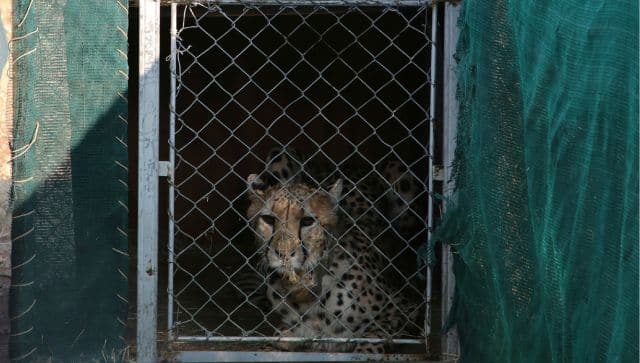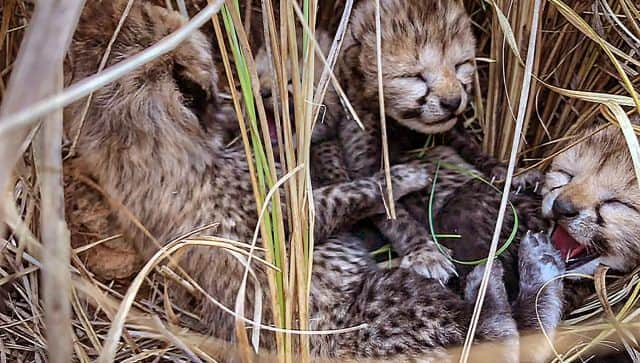Another cheetah has died at Madhya Pradesh’s Kuno National Park (KNP), taking the death toll of the felines to nine. As per officials, a female African cheetah ‘Dhatri’ (Tiblisi) was found dead on Wednesday (2 August), making it the sixth adult big cat to have died since March. “This morning, one of the female cheetahs — Dhatri (Tiblisi) — was found dead. To determine the cause of the death, a post-mortem is being conducted,” news agency PTI quoted a statement from the MP forest department as saying. As per Indian Express, wildlife officials were trying to track two remaining free-range cheetahs, Dhatri and Nirva, to bring them back to their enclosures to check for any infections. Nirva is yet to be found, the report added. Let’s take a closer look at how the cheetah deaths have hit India’s ambitious plans to revive the feline population. Nine cheetahs die in Kuno India reported its first cheetah death on 27 March when a Namibian female cheetah named Sasha died of a kidney ailment. In April, one of the male cheetahs from South Africa, Uday, died from cardio-pulmonary failure, as per ThePrint. South African cheetah Daksha’s death in May was attributed to a “violent interaction” with a male feline during mating. July saw back-to-back deaths of two male cheetahs, Suraj and Tejas. According to ThePrint, an initial autopsy had mentioned that Tejas could not recover from “traumatic shock” after a fight with another female cheetah. However, some reports blamed
satellite collars
– gadgets put around the necks of cheetahs to track and monitor their movements – for causing infections. “An infection breaking out because of the radio collar due to the monsoon is a possibility. In these cases, because of high moisture, the cheetah may scratch its skin, which can break and an infection can break out after contact with a fly. It may also be one of the reasons for the cheetah deaths. We need a thorough examination to see if there are other causes. Both cheetahs have similar organ damage — their kidneys, heart, spleen and kidneys were damaged. The radio collar is not the fatal issue, it can be a contributing factor and it must be addressed,” the then Madhya Pradesh principal chief conservator of forests (wildlife) JS Chauhan had told Indian Express last month. [caption id=“attachment_12950832” align=“alignnone” width=“640”] Kuno now has 14 African cheetahs – seven males, six females and one female cub. AP File Photo[/caption] As per ThePrint, Chauhan was later sacked from his post, with the environment ministry calling claims of cheetah deaths linked to radio collars “hearsay” and “speculation”. However, an exercise was carried out to remove radio collars from the 10 free-ranging cheetahs after some wildlife experts suggested they may be linked to infections, reported Indian Express. It must be noted that a total of 20 felines were translocated from Namibia and South Africa to the KNP under Project Cheetah. Later, four cubs were born to the female Namibian cheetah ‘Jwala’, out of which three cubs died.
Kuno now has 14 African cheetahs – seven males, six females and one female cub. AP File Photo[/caption] As per ThePrint, Chauhan was later sacked from his post, with the environment ministry calling claims of cheetah deaths linked to radio collars “hearsay” and “speculation”. However, an exercise was carried out to remove radio collars from the 10 free-ranging cheetahs after some wildlife experts suggested they may be linked to infections, reported Indian Express. It must be noted that a total of 20 felines were translocated from Namibia and South Africa to the KNP under Project Cheetah. Later, four cubs were born to the female Namibian cheetah ‘Jwala’, out of which three cubs died.
Currently, KNP has 14 cheetahs – seven males, six females and one female cub, which are being kept in bomas (enclosures).
According to MP principal chief conservator of forests (wildlife) Aseem Shrivastava, all these felines are “healthy and their health is being regularly monitored by the team comprising Kuno wildlife veterinarians and the Namibian expert”, reported Indian Express. Deaths due to ‘natural causes’ Earlier this week, the Centre told the Supreme Court that the death of cheetahs was due to “natural causes” and not because of the “inherent unsuitability” of the Kuno National Park. In May, the apex court had asked the government to look at “alternate sites” for the cheetahs, either in Madhya Pradesh or Rajasthan. The Central government said in its affidavit, as per Hindustan Times (HT): “Provisional diagnosis of mortality events point towards natural causes and none of the cheetahs have died due to unnatural reasons such as poaching, snaring, poisoning, road hits, electrocution, etc.” The Centre said, citing “general scientific awareness” of the survival of cheetahs in the wild, that these felines have a survival rate of around 50 per cent in adults even in “non-introduced population”, reported HT. The affidavit added that this rate drops further when the carnivores are introduced into a habitat. Cubs may have only 10 per cent survival in such situations, the Centre told the top court. [caption id=“attachment_12950812” align=“alignnone” width=“640”] three cubs born to a translocated African cheetah have died so far in Kuno. PTI File Photo[/caption] After the
first six cheetahs died in two months
at Kuno, experts had said that these fatalities were not a cause for worry. South Africa’s Department of Forestry, Fisheries and the Environment had said in a statement in May, “Large carnivore reintroductions are extremely complex and inherently risky operations. This is a critical phase of the project, with cheetahs being released into larger environments where there is increasingly less control over their day-to-day wellbeing. The risks for injury and mortality will be increasing and these risks are factored into the reintroduction plan.” “Many of the released cheetahs will escape the boundaries of Kuno National Park and may have to go through short-term stress during the recapture process,” the statement added. “Once the cheetahs have established home ranges, the situation will stabilise.” Foreign experts write to Supreme Court Recently, a letter sent by South African and Namibian experts, members of the national cheetah project steering committee under which 20 cheetahs were translocated from Africa to India, to the Supreme Court has come to light. According to The Quint, in the letter dated 15 July, these experts lamented being kept in the dark about the translocated cheetahs, as well as raised “serious concerns” over the project’s management. The experts said that some of the cheetah deaths “could have been prevented by better monitoring of the animals and more appropriate veterinary care” if the experts had been apprised rather than ignoring and using them as mere “window-dressing”, reported Indian Express. “Very little information has been forthcoming from Kuno regarding the cheetahs and their care. Although we are listed on the Cheetah Project Steering Committee as international experts, we have never been consulted by them or invited to any of their meetings,” the letter signed by South African veterinary wildlife specialist Dr Adrian Tordiff said. Dr Tordiffe signed the letter on behalf of his colleagues – cheetah specialist Vincent van der Merwe, as well as wildlife veterinarians Dr Andy Fraser and Dr Mike Toft. However, van der Merwe told Indian Express he was “not involved” when asked about the letter. According to the letter, the forest officers and vets had wrongly assumed that the male cheetah, who was found with wounds on the back of his neck at around 11 am on 11 July, was injured by a female cheetah, which was an “extremely unlikely” scenario. “The staff at Kuno left the injured male and did not try to locate the female to check if she was also injured following which the condition of the male deteriorated, and he died after a few hours without having received any treatment,” Indian Express quoted the letter as saying. The letter said that if the experts had been shown pictures or had a description of the “wounds,” they would have made the diagnosis and alerted authorities about the problem. “This would have allowed the appropriate action to be taken to minimise the risks to the other animals,” The Quint quoted the letter as saying. With inputs from agencies
three cubs born to a translocated African cheetah have died so far in Kuno. PTI File Photo[/caption] After the
first six cheetahs died in two months
at Kuno, experts had said that these fatalities were not a cause for worry. South Africa’s Department of Forestry, Fisheries and the Environment had said in a statement in May, “Large carnivore reintroductions are extremely complex and inherently risky operations. This is a critical phase of the project, with cheetahs being released into larger environments where there is increasingly less control over their day-to-day wellbeing. The risks for injury and mortality will be increasing and these risks are factored into the reintroduction plan.” “Many of the released cheetahs will escape the boundaries of Kuno National Park and may have to go through short-term stress during the recapture process,” the statement added. “Once the cheetahs have established home ranges, the situation will stabilise.” Foreign experts write to Supreme Court Recently, a letter sent by South African and Namibian experts, members of the national cheetah project steering committee under which 20 cheetahs were translocated from Africa to India, to the Supreme Court has come to light. According to The Quint, in the letter dated 15 July, these experts lamented being kept in the dark about the translocated cheetahs, as well as raised “serious concerns” over the project’s management. The experts said that some of the cheetah deaths “could have been prevented by better monitoring of the animals and more appropriate veterinary care” if the experts had been apprised rather than ignoring and using them as mere “window-dressing”, reported Indian Express. “Very little information has been forthcoming from Kuno regarding the cheetahs and their care. Although we are listed on the Cheetah Project Steering Committee as international experts, we have never been consulted by them or invited to any of their meetings,” the letter signed by South African veterinary wildlife specialist Dr Adrian Tordiff said. Dr Tordiffe signed the letter on behalf of his colleagues – cheetah specialist Vincent van der Merwe, as well as wildlife veterinarians Dr Andy Fraser and Dr Mike Toft. However, van der Merwe told Indian Express he was “not involved” when asked about the letter. According to the letter, the forest officers and vets had wrongly assumed that the male cheetah, who was found with wounds on the back of his neck at around 11 am on 11 July, was injured by a female cheetah, which was an “extremely unlikely” scenario. “The staff at Kuno left the injured male and did not try to locate the female to check if she was also injured following which the condition of the male deteriorated, and he died after a few hours without having received any treatment,” Indian Express quoted the letter as saying. The letter said that if the experts had been shown pictures or had a description of the “wounds,” they would have made the diagnosis and alerted authorities about the problem. “This would have allowed the appropriate action to be taken to minimise the risks to the other animals,” The Quint quoted the letter as saying. With inputs from agencies
)